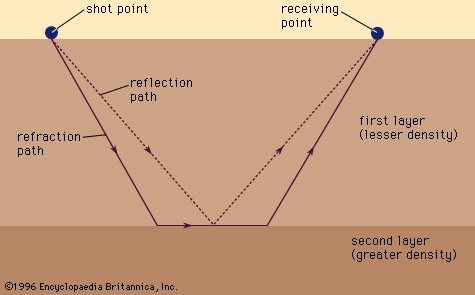seismic survey
method of investigating subterranean structure, particularly as related to exploration for petroleum, natural gas, and mineral deposits (mineral deposit). The technique is based on determinations of the time interval that elapses between the initiation of a seismic wave at a selected shop point and the arrival of reflected or refracted impulses at one or more seismic detectors. Though dynamite exploded (explosion seismology) underground is most commonly used to initiate the seismic waves, an electric vibrator or falling weight (thumper) may also be employed at sites where an underground explosion might cause damage—e.g., where caverns are present. Upon arrival at the detectors, the amplitude and timing of waves are recorded to give a seismogram (record of ground vibrations).
 The illustration-->
The illustration--> depicts seismic survey methods in simplified form. Generally, the density of rocks near the surface of the Earth increases with depth. Seismic waves initiated at the shot point may reach the receiving point by reflection, refraction, or both. When the shot point is close to the receiving point, reflected waves usually reach the receiving point first. At greater distances, however, the seismic pulse travels faster by the refraction path because its velocity is greater along the top of the lower, denser layer than it is through the upper layer; in this case, the refracted wave arrives first.
depicts seismic survey methods in simplified form. Generally, the density of rocks near the surface of the Earth increases with depth. Seismic waves initiated at the shot point may reach the receiving point by reflection, refraction, or both. When the shot point is close to the receiving point, reflected waves usually reach the receiving point first. At greater distances, however, the seismic pulse travels faster by the refraction path because its velocity is greater along the top of the lower, denser layer than it is through the upper layer; in this case, the refracted wave arrives first.Interpretation of the depths and media reached by seismic waves thus depends on the distance between shot points and receiving points and the densities of the strata. The results of a seismic survey may be presented in the form of a cross-sectional drawing of the subsurface structures as if cut by a plane through the shot point, the detector, and the centre of the Earth. Such drawings are called seismic profiles.
- Loys Bourgeois
- Loyset Compère
- Lozi
- Loíza River
- Loṭf ʿAlī Khān Zand
- L. Paul Bremer, III
- L. Paul, III Bremer
- L P Hartley
- L.S. Amery
- LSD
- L.S. Lowry
- Ltd. All Nippon Airways Co.
- Ltd. British Leyland Motor Corporation
- Ltd. Hitachi
- Ltd. Honda Motor Company
- Ltd. Idemitsu Kōsan Co.
- Ltd. Ishikawajima-Harima Heavy Industries Company
- Ltd. Kawasaki Heavy Industries
- Ltd. Kōbe Steel
- Ltd. Matsushita Electric Industrial Company
- Ltd. Nissan Motor Co.
- Ltd. Shōchiku Co.
- Ltd. Takashimaya Co.
- Ltd. Tōei Company
- Lu